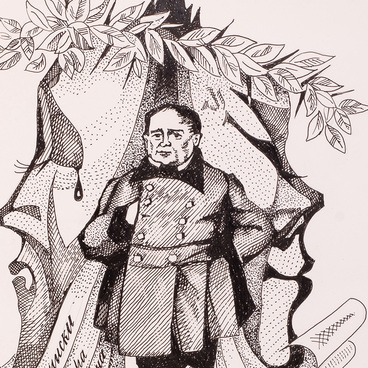The book “Conversations on the Acts of the Apostles” is a characteristic example of printing of the second half of the 18th century. It included two important works of the Fathers of the Church: “Explanations on the Acts of the Apostles”, compiled by Saint John Chrysostom, and “Explanation on the Apocalypse” by Saint Andreas of Caesarea. The text is accompanied by a number of indices. The appearance of this kind of book supplemented with indices became a significant stage in the development of both biblical studies and book printing, in general.
As early as the end of the 17th and especially in the 18th century, publishers began to move away from the early printed style of book design. “Full” Baroque, which was the predominant style of the time, found its way into the ornamentation; imitations of Western European engraving with architectural backgrounds, canopies, the arch of King David, and other similar artistic elements became common.
The printed text, as a rule, corresponded to the general style of the books of Holy Scripture, with the words of interpretation (which ran parallel to the main text) given in smaller print.
The Acts of the Apostles (“Acts”) is a work written by Luke the Apostle; the events described begin from the Ascension of Christ (that is, from the end of the Third Gospel). Saint Luke created a real historical chronicle covering a wide geography of action (from Jerusalem to Rome) and a large number of historical characters. He accurately named 32 areas, 54 towns, and 95 characters.
“Acts” is devoted to the history of the formation of the Christian Church in the first thirty years of its existence. Chapters 1 through 12 deal with the founding of the Church and the preaching of the apostles in Palestine; chapters 13 through 28 mainly describe the mission of Paul the Apostle in Asia Minor, Greek cities, and the Eastern Mediterranean, where Luke was an associate of his.
Saint John Chrysostom wrote his Interpretations of Acts in the mid-400s while in Constantinople. The Interpretations touch on various issues of the spiritual life of believers, discuss the nature and meaning of miracles (opposing them to magic), speak of the need for prayer, the study of Holy Scripture, and the cultivation of the virtues of humility and charity, and condemn the custom of taking oaths.
Little is known about Saint Andreas of Caesarea, Archbishop of Caesarea in Cappadocia. His extended patristic commentary on the Apocalypse, one of the first of its kind, created between 563 and 614, had a great influence on later theological thought.
As early as the end of the 17th and especially in the 18th century, publishers began to move away from the early printed style of book design. “Full” Baroque, which was the predominant style of the time, found its way into the ornamentation; imitations of Western European engraving with architectural backgrounds, canopies, the arch of King David, and other similar artistic elements became common.
The printed text, as a rule, corresponded to the general style of the books of Holy Scripture, with the words of interpretation (which ran parallel to the main text) given in smaller print.
The Acts of the Apostles (“Acts”) is a work written by Luke the Apostle; the events described begin from the Ascension of Christ (that is, from the end of the Third Gospel). Saint Luke created a real historical chronicle covering a wide geography of action (from Jerusalem to Rome) and a large number of historical characters. He accurately named 32 areas, 54 towns, and 95 characters.
“Acts” is devoted to the history of the formation of the Christian Church in the first thirty years of its existence. Chapters 1 through 12 deal with the founding of the Church and the preaching of the apostles in Palestine; chapters 13 through 28 mainly describe the mission of Paul the Apostle in Asia Minor, Greek cities, and the Eastern Mediterranean, where Luke was an associate of his.
Saint John Chrysostom wrote his Interpretations of Acts in the mid-400s while in Constantinople. The Interpretations touch on various issues of the spiritual life of believers, discuss the nature and meaning of miracles (opposing them to magic), speak of the need for prayer, the study of Holy Scripture, and the cultivation of the virtues of humility and charity, and condemn the custom of taking oaths.
Little is known about Saint Andreas of Caesarea, Archbishop of Caesarea in Cappadocia. His extended patristic commentary on the Apocalypse, one of the first of its kind, created between 563 and 614, had a great influence on later theological thought.






